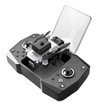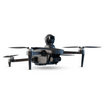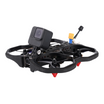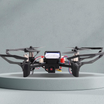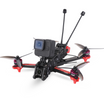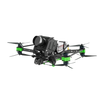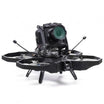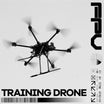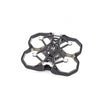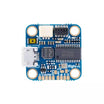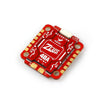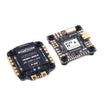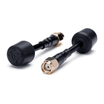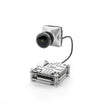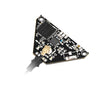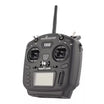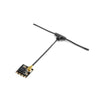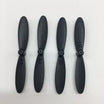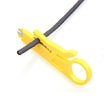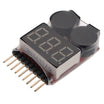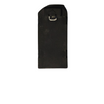Forget souped-up sports cars and dusty racetracks; the adrenaline rush of the future has taken flight. Welcome to the exhilarating world of drone racing, where high-tech meets high-speed in a mind-bending spectacle of human and machine pushing the limits of both physics and imagination.
Imagine strapping on a pair of sleek FPV goggles, the real world dissolving into a dreamscape. Your grip tightens on a controller, sending silent commands to a sleek, agile drone rushing through a custom-built course. Buildings blur past, trees whip by, and your stomach lurches as you navigate through the racing field. This, my friends, is the heart of FPV racing - a symphony of speed, precision, and split-second reflexes played out across neon-lit racetracks and a serenic view of the racing track.
Unlocking the FPV Experience:
The revolutionary FPV technology is the foundation of drone racing. First Person View offers a mind-bending and immersive experience by allowing pilots to see their drones through their eyes in real time. Pilots are in the controls, making split-second decisions and refining their precision flying skills while the drone flies through the air at fast speeds.
As pilots glide between obstacles, bank through tight corners, and soar through neon-lit gates—all while keeping total control through their FPV goggles—the adrenaline rush is unparalleled. It's an adventure into the future where human skill and technology combine to alter the limits of sport, not simply a race.
Techno Marvels: A Racing Drone's Anatomy
A racing drone isn't like your typical store-bought device. It is a meticulously constructed technological masterpiece that combines durability, speed, and agility. Let's examine the essential elements that comprise these soaring creatures in more detail:
- Frame: A racing drone's frame is usually composed of strong, lightweight materials like carbon fibre. This ensures the drone's continuous agility in the face of the inevitable crashes and damages that occur in high-speed racing.
- Motors and Propellers: Strong brushless motors give racing drones the thrust necessary to achieve amazing speeds. These parts, when combined with aerodynamically shaped propellers, have been precisely set for optimal effectiveness, enabling the drone to achieve remarkable speeds.
- Flight Controller: A highly developed flight controller, which serves as the machine's brain, is at the core of every racing drone. It analyses information from multiple sensors, maintains drone stability while in flight, and precisely carries out the pilot's instructions.
- Camera and FPV System: A racing drone's camera serves as the pilot's eyes in the sky as well as a tool for taking beautiful footage. It offers real-time video feed to the pilot's goggles when combined with a low-latency FPV system, enabling quick control and an engaging racing experience.
- Radio Transmitter and Receiver: To give the drone control signals, pilots utilise a radio transmitter. The drone's receiver decodes these signals, allowing the pilot to perform accurate moves. The ability to communicate instantly is essential for navigating through complex race courses.
- Emotions During the Race: Drone racing is an immersive sport that captivates fans and competitors equally with its sensory presentation. The excitement of the race is found in the pilots' calculated decisions just as much as in their lightning-fast speeds and spectacular movements.
The Challenges: A Collection of Complications
Drone racing systems are an amazing display of mechanical expertise and creativity. These courses, which are set in a variety of settings including abandoned warehouses and famous sites, are specifically created to put pilots' skill, quickness, and strategic thinking to the test.
- Gates and Flags: The racecourse's checkpoints are indicated by neon-lit gates and flags, which present a challenge for pilots as they navigate through confined passages and make exact turns.
- Tunnels and Tiers: To add even more complexity, some courses have tunnels and multi-tiered buildings. Pilots have to navigate such obstacles with skill, displaying their adaptability to different race tracks.
- Elevation Changes: Racing drones aren't limited to just one level; some courses have shifting elevations that pilots must quickly ascend and descend. It's a dynamic component that gives the race a further dimension.
What started off as a hobby for drone enthusiasts has developed into a worldwide phenomenon that draws viewers of all ages. Pilots are now considered sports heroes thanks to the emergence of professional drone racing leagues, where spectators support their favourite competitors and are in admiration of their incredible abilities.
Events featuring drone racing attract large audiences due to their immersive nature and competitive nature. Large screens show the live FPV feeds, placing viewers in the virtual canopy with the pilots so they can watch the action. Innovative technology paired with expert piloting produces an entertainment experience that goes beyond traditional sports.
The Rise of Drone Racing in India: A High-Tech Revolution
In the dynamic landscape of sports and technology, India has emerged as a hub for the exhilarating world of drone racing. Fueled by a diverse landscape and a tech-savvy population, the nation has warmly embraced this futuristic phenomenon. What initially began as informal gatherings among drone enthusiasts has rapidly transformed into organised races and championships, painting a vibrant picture of the drone racing community in India.
One of the driving forces behind this surge is the Indian Drone Racing League (IDRL), an organisation at the forefront of promoting and organising drone racing events across the country. The IDRL has played a pivotal role in bringing structure and recognition to the sport, fostering a sense of community among drone pilots and enthusiasts.
By launching the first-ever live stream in the heart of the Indian Drone Racing League (IDRL), InsideFPV achieved a groundbreaking move. By utilising cutting-edge drone technology, InsideFPV's aerial expertise records the race from amazing angle points, raising the bar for sports coverage's immersion and excitement. In collaboration with IDRL, InsideFPV has seamlessly integrated high-definition drone broadcasts into the racing experience. The drones, which are equipped with cutting-edge cameras, take to the air and turn into flying cameras that provide spectators an immersive, real-time experience. This historic occasion combines excitement and innovation as InsideFPV's technology revolutionises how drone racing is presented to the public.
Advancements in Race Drone Technology: Unleashing the Future with Advik
In the pulsating world of drone racing, where every gram and millisecond make the difference between victory and defeat, technological innovation is the driving force propelling the sport to unprecedented heights. At the forefront of this revolution is Advik—a cutting-edge race drone that stands as a testament to the pinnacle of advancements in drone racing technology. More than just a quadcopter, Advik is a marvel of engineering, a fusion of stability, durability, and dynamic capabilities that redefine the very essence of professional drone racing. What sets Advik apart is its state-of-the-art features, each meticulously designed to elevate the racing experience. Boasting a stable and durable freestyle, long-range quad structure, Advik is a powerhouse that pushes the boundaries of what's possible in the world of drone racing.
Advik : Powerpack of features for Drone Racing League
- Camera Quality: Advik's outstanding camera, which supports resolutions of up to 720p, 1080p, and even 4K, allows for the amazing detail capture of every race. During high-speed races, pilots can make better decisions and maintain control to a clear and crisp visual.
- Operating Frequency: Advik minimises interference, guarantees a flawless connection, and provides pilots with a reliable link to their drones by operating at 2.4 GHz. This frequency improvement is revolutionary, particularly in dense racing situations.
- Speed: Advik is a speed maniac on the racetrack, reaching top speeds of 180 km/h. Its dynamic capabilities push the boundaries of what is possible and provide an exhilarating experience for both pilots and spectators.
- Range and flying Duration: Advik gives pilots plenty of time for racing and exploring, with a range of up to 3 km and a flying duration of up to 15 minutes.
- Versatility: Advik adjusts with ease whether travelling through parks, forests, open fields, meadows, mountains, hills, cities, or deserts. The robust design and integrated GPS enable it to be used in a variety of settings and terrains, providing an unmatched racing experience.
In the dynamic world of drone racing, where cutting-edge technology meets high-speed thrills, the sport has become a global spectacle. From the adrenaline-fueled races on neon-lit tracks to the immersive experience of FPV flying, drone racing has captured the imagination of enthusiasts worldwide. The rise of professional leagues, like the Indian Drone Racing League (IDRL), has propelled India into the forefront of this high-tech revolution. At the heart of this technological evolution is Advik, a drone that embodies the pinnacle of advancements in drone racing technology. With its exceptional camera quality, operating frequency, speed, range, and versatility, Advik stands as a testament to the fusion of stability, durability, and dynamic capabilities.
FAQs
Q1: What is FPV racing?
FPV racing, or First Person View racing, is a high-speed sport where drone pilots use FPV goggles to navigate their drones through custom-built courses. It's considered the future of racing due to its immersive nature, combining cutting-edge technology with high-speed thrills. One of the best choices in the market for FPV drones is insideFPV’s Advik.
Q2: How are racing drones different from typical store-bought drones?
Racing drones are meticulously constructed technological masterpieces designed for speed, durability, and agility. They feature strong, lightweight frames, powerful brushless motors, advanced flight controllers, high-quality cameras, and FPV systems, setting them apart from standard consumer drones.
Q3: How fast is a racing drone?
When it comes to racing drones, speed is of the essence, and these high-performance machines often exceed 160 km/h. Advik, a top choice among racing drones, takes the thrill to the next level by offering an impressive speed of 180 km/h.

